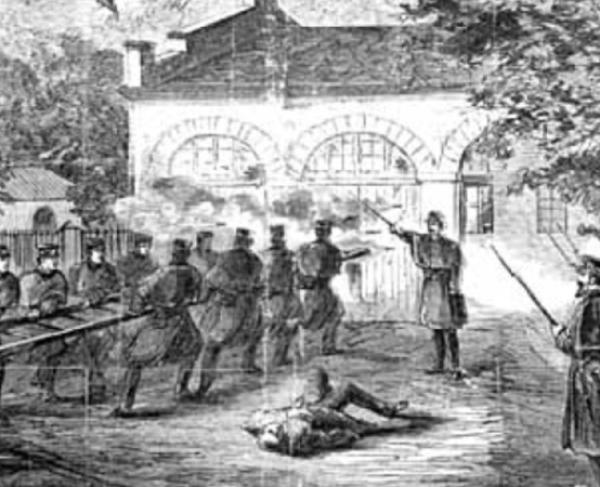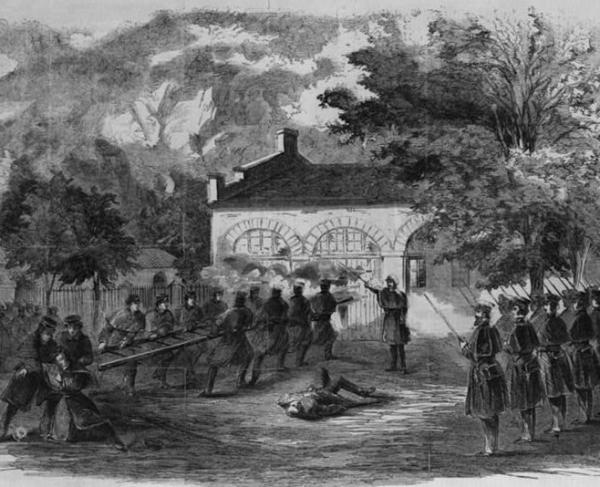
Although the radical abolitionist assault on the U.S. armory and arsenal at Harpers Ferry has gone down in history as John Brown’s Raid, the 59-year-old John Brown was accompanied by 21 others — 16 white men, three free blacks, one freed slave and one fugitive slave. Only five escaped the raid and its aftermath. Four bodies of those killed in the raid or executed for treason were used as teaching cadavers by a local medical college. Many of the raiders were subsequently relocated to a mass grave in North Elba, N.Y., alongside Brown.
Jeremiah Anderson, 26, was mortally wounded by a Marine’s bayonet during the final assault on the engine house.
Osbourne Perry Anderson, 29, a free African American who was living in Canada when recruited for the raid, survived and escaped by returning to Canada on foot. He went on to write a memoir of the raid and serve in the Union Army before dying of tuberculosis in 1872.
Oliver Brown, 21, was the youngest of John Brown’s three sons to participate in the action. He was mortally wounded on the 17th, dying the next day.
Owen Brown, 34, was the only one of Brown’s sons to survive the raid. He later moved to California with the remaining members of the family.
Watson Brown, 24, was mortally wounded on October 17 while carrying a white flag and trying to negotiate with the responding militia. He died two days later.
John E. Cook, 30, the effort’s chief quartermaster, had moved to the area well in advance of the raid, teaching school and even marrying a local woman. Out of the area gathering supplies during the raid itself, he reunited with the survivors as they made their way north. Captured in Pennsylvania, he was executed in Charles Town on December 16.
John Anthony Copeland, Jr., 25, a free African American who had been a student at Oberlin College in Ohio, but joined the raiders along with his uncle Lewis Leary. Captured during the raid, he was executed on December 16.
Barclay Coppoc, 20, unlike his elder brother, escaped the raid and went on to become a lieutenant in the 3rd Kansas Infantry. He died on September 3, 1861, of injuries sustained when his transport train fell into the Platte River, off a bridge sabotaged by Confederates.
Edwin Coppoc, 24, shot and killed Harpers Ferry mayor Fontaine Beckham during the raid. He was executed at Charles Town on December 16.
Shields Green, approximately 23, an escaped slave from South Carolina, he was captured in the engine house and executed on December 16.
Albert Hazlett, 22, held the armory building itself during the raid, escaping across the Potomac as the situation worsened. He was captured at Carlisle, Penn., on October 22, tried and executed at Charles Town on March 16, 1860.
John Henry Kagi, 24, Brown’s second in command was stationed in the U.S. Rifle Factory during the raid. Realizing he was hopelessly outnumbered, Kagi attempted to escape across the Shenandoah River, but was shot and killed.
Lewis Leary, 24, another free African-American, was stationed in the rifle factory with Kagi and also shot while trying to escape across the Shenandoah. He died 10 hours later.
William Leeman, 20, a veteran of Brown’s efforts in Kansas, was killed attempting to escape across the Potomac River on October 17.
Francis Jackson Meriam, 21, blind in one eye, served as one of three members of Brown’s rear guard, stationed in Maryland. He escaped the raid and went on to serve as a captain in the 3rd South Carolina Colored Infantry, dying in November 1865.
Dangerfield Newby, approximately 35, was born into slavery, despite having a white father, who was not his master. With the permission of his owner, he moved to Ohio along with his mother and siblings, but when he tried to also buy the freedom of his wife and children, the owner refused, leading Newby to join Brown. He was the first raider killed, and his family was sold downriver to Louisiana.
Aaron Stephens, approximately 26, was wounded while carrying a flag of truce and carried to a nearby hotel. Tried and convicted, he was hanged on March 16, 1860.
Stewart Taylor, 22, born a Canadian, was killed defending the engine house on October 17. First buried in Harpers Ferry, he was later moved to a grave near John Brown in North Elba, N.Y.
Dauphin Thompson, 21, one of two brothers killed in the raid, he died of a bayonet wound as the Marines stormed the engine house.
William Thompson, 26, was captured when he and others emerged carrying a flag of truce. After Mayor Fontaine Beckham was killed, the mob shot Thompson in the head and tossed his body in the Shenandoah to use for target practice.
Charles Plummer Tidd, 25, returned to Maryland for more supplies after the raid commenced, escaping along with the rest of the rear guard. He went on to enlist in the 21st Massachusetts but died of fever in February 1862.


